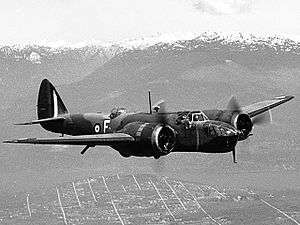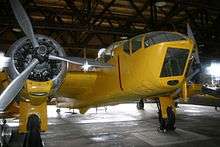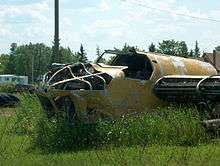Bristol Bolingbroke
| Bolingbroke | |
|---|---|
 | |
| Bolingbroke | |
| Role | Maritime patrol aircraft |
| Manufacturer | Bristol Aeroplane Company Fairchild Aircraft Ltd. (Canada) |
| First flight | 14 September 1939 |
| Introduction | 15 November 1939 |
| Primary user | Royal Canadian Air Force |
| Produced | 1939–1943 |
| Number built | 626 |
| Developed from | Bristol Blenheim |
The Bristol Fairchild Bolingbroke was a maritime patrol aircraft used by the Royal Canadian Air Force during the Second World War. Built by Fairchild-Canada, it was a variant of the Bristol Blenheim Mk IV bomber.
Design and development
In 1935, the British Air Ministry issued Specification G.24/35 to procure a coastal reconnaissance/light bomber to replace the Avro Anson.[1] Bristol proposed the Type 149, based on its Blenheim Mk I, with Bristol Aquila engines to give greater range. While the Air Ministry rejected this proposal, a Blenheim Mk I, retaining its Mercury VIII engines, was converted as a Type 149 (Blenheim Mk III) for the general reconnaissance role.[2] The nose was lengthened to provide more room for the bombardier, with the upper left surface of the nose being scooped out to maintain pilot visibility during takeoff and landing.[1]
The longer range also fulfilled a Canadian requirement for a maritime patrol aircraft. Consequently, Fairchild Aircraft Ltd. (Canada) of Quebec started production of the Blenheim Mk IV as the Bolingbroke (the originally intended name for the Blenheim IV). This type was nicknamed the "Bolly". After a small run of aircraft constructed to British specifications, as the Bolingbroke Mk I, Fairchild switched production to the Bolingbroke Mk IV with Canadian and American instruments and equipment. These versions also included anti-icing boots and a dinghy. One of the early Mk IV variants was the Bolingbroke Mk IVW which was powered by two 825 hp (615 kW) Pratt & Whitney SB4G Twin Wasp Junior engines.[3] Incapable of maintaining altitude on one engine, the normal bomb load was reduced to 500 pounds on these aircraft to compensate for the low engine power.[4] The most-produced variant was the Bolingbroke Mk IVT trainer, of which 457 were completed.[5] A total of 626 Bolingbrokes were produced.[5]
Operational history

Most of the 151 Mk IVs built served in their intended role as patrol bombers on the Atlantic and Pacific coasts of Canada between 1940 and 1944. Two squadrons of these aircraft also served in Alaska during the Aleutians campaign.[6] The Mk IVT trainers saw extensive use in the British Commonwealth Air Training Plan (BCATP).[5]
Variants
- Bolingbroke Mk I
- Twin-engine maritime patrol bomber aircraft, powered by two Bristol Mercury VIII radial piston engines, with British equipment. 18 built.[7]
- Bolingbroke Mk II
- Conversion of fifth Mk I with US equipment - prototype of Mk IV.[8]
- Bolingbroke Mk III
- Floatplane conversion of sixteenth Bolingbroke Mk I, with two Edo floats.[8][9]
- Bolingbroke Mk IV
- Twin-engine maritime patrol bomber aircraft, equipped with anti-icing boots and a dinghy, also fitted with American and Canadian instruments and equipment, powered by two Bristol Mercury XV radial piston engines, 134 built.[10]
- Bolingbroke Mk IVW
- Sub-version of Mk IV powered by two 825 hp (615 kW) Pratt & Whitney SB4G Twin Wasp Junior radial piston engines as contingency against possible shortages of Mercury engines. The Mk IVW's performance was below that of the Mk IV and the supply of the British engines was maintained so production returned to the Mk IV after only 15 aircraft were built.[10][11]
- Bolingbroke Mk IVC
- Version of Mk IV with 900 hp (671 kW) Wright R-1820 Cyclone engines not requiring high octane fuel. One built.[12]
- Bolingbroke Mk IVT
- Multi-purpose trainer aircraft. A total of 350 built powered by Mercury XV engines, followed by a further 107 powered by the low-octane fuel Mercury XX* engine, giving a total of 457 built, with a further 51 cancelled.[13] Six Mk IVT were converted to dual controls. A further 89 were converted to Mk IVTT Target Tug with the addition of winching gear in the rear cabin and target drogue storage in the bomb bay.[14]
Operators
- Royal Canadian Air Force
- Operational Squadrons of the Home War Establishment (HWE):
- No. 8 Squadron RCAF - Used Bolingbroke Mk I and Mk IV (Dec 40 – Aug 43)[15]
- No. 115 Squadron RCAF - Used Bolingbroke Mk I (Aug 41 to Dec 41) and Mk IV (Nov 41 – Aug 43)[16]
- No. 119 Squadron RCAF - Used Bolingbroke Mk I (Aug 40 - Aug 41), Mk IVW (Aug–Nov 41) and Mk IV (Nov 41 – Jun 42)[17]
- No. 147 Squadron RCAF - Used Bolingbroke Mk I and Mk IV (Jul 42 – Mar 44)[18]
- The following HWE squadrons only had small numbers of Bolingbrokes on strength:[19]
- No. 13 (OT) Squadron RCAF - Used Bolingbroke Mk IV (Oct 41 – Jun 42)[20]
- No. 121 (K) Squadron RCAF - Used Bolingbroke Mk IVTT (Target Tug) (Aug 42 – May 44)[21]
- No. 122 (K) Squadron RCAF - Used Bolingbroke Mk IVTT (Target Tug) (Aug 42 – Sep 45)[22]
- No. 163 (AC) Squadron RCAF - Used Bolingbroke Mk IV (Mar–Jun 43)[23]
- (BR)-Bomber Reconnaissance; (OT)-Operational Training; (K)-Auxiliary; (AC)-Army Co-operation
- Operational Squadrons of the Home War Establishment (HWE):
- British Commonwealth Air Training Plan (BCATP)
- Bombing and Gunnery Schools
- No. 1 B&G School - Jarvis, Ontario, Used Bolingbroke IVT (Aug 40 – Feb 45)
- No. 2 B&G School - Mossbank, Saskatchewan, Used Bolingbroke IVT (Oct 40 – Dec 44)
- No. 3 B&G School - Macdonald, Manitoba, Used Anson, Battle, Bolingbroke IVT and Lysander, (Mar 41 – Feb 45)
- No. 4 B&G School - Fingal, Ontario, Used Bolingbroke IVT (Nov 40 – Feb 45)
- No. 5 B&G School - Dafoe, Saskatchewan, Used Bolingbroke IVT (Apr 41 – Feb 45)
- No. 6 B&G School - Mountain View, Ontario, Used Bolingbroke IVT (Jun 41 – Post War)
- No. 7 B&G School - Paulson, Manitoba, Used Bolingbroke IVT (Jun 41 – Feb 45)
- No. 8 B&G School - Lethbridge, Alberta, Used Bolingbroke IVT (Oct 41 – Dec 44)
- No. 9 B&G School - Mont-Joli, Quebec, Used Bolingbroke IVT (Dec 41 – Apr 45)
- No. 10 B&G School - Mount Pleasant, Prince Edward Island, Used Bolingbroke IVT (Sep 43 - Jun 45)
- No. 31 B&G School (RAF) - Picton, Ontario, Used Bolingbroke IVT (Apr 41 - Nov 44) — currently Picton Airport
- Bombing and Gunnery Schools
Survivors


.jpg)
- IV Canadian Warplane Heritage Museum, Hamilton, Ontario. This is being rebuilt to airworthy status from the remains of eight separate aircraft.
- IV 9048 Bristol Aero Collection, Filton, Bristol, under restoration.
- IV 9059 Commonwealth Air Training Plan Museum in Brandon, Manitoba.
- IV 9104 British Columbia Aviation Museum, Victoria, British Columbia.
- IVT 9869 Royal Aviation Museum of Western Canada, Winnipeg, Manitoba. In storage.
- IVT 9887 17 Wing Winnipeg, Winnipeg, Manitoba. Aircraft donated from farm in 2013, indoor storage awaiting cosmetic restoration.
- IVT 9892 Canada Aviation and Space Museum, Rockcliffe, Ontario.
- IVT 9895 Royal Museum of the Armed Forces and of Military History, Brussels, Belgium.
- IVT 9940 National Museum of Flight, Scotland, under restoration.
- IVT 9944 Commonwealth Air Training Plan Museum in Brandon, Manitoba. This aircraft is displayed next to the Trans-Canada Highway in Brandon.
- IVT 9987 Bomber Command Museum of Canada, Nanton, Alberta.
- IVT 9997 Greenwood Military Aviation Museum, Greenwood, Nova Scotia. Undergoing restoration.
- IVT 10001 Royal Air Force Museum, London.
- IVT 10076 Painted as 9118 that sunk Shch-138 July 1942 Pima Air & Space Museum, Tucson, Arizona.
- IVT 10120 Reynolds-Alberta Museum, Wetaskiwin, Alberta.
- IVT 10201 This was restored to airworthy condition by the Aircraft Restoration Company at Imperial War Museum Duxford as G-BPIV. It is currently being fitted with a Blenheim Mk I nose which had previously been converted to a car.
- IVT 10209 17 Wing Winnipeg, Winnipeg, Manitoba. Fuselage and wing roots only. Stored outdoors.
Specifications (Bolingbroke Mk IV)
Data from War Planes of the Second World War: Volume Seven Bombers and Reconnaissance Aircraft [24]
General characteristics
- Crew: three
- Length: 42 ft 9 in (13.03 m)
- Wingspan: 56 ft 4 in (17.17 m)
- Height: 9 ft 10 in (3.00 m)
- Wing area: 469 ft² (43.6 m²)
- Empty weight: 9,835 lb (4,470 kg)
- Loaded weight: 13,750 lb (6,250 kg)
- Max. takeoff weight: 14,500 lb (6,591 kg)
- Powerplant: 2 × Bristol Mercury XV nine-cylinder air-cooled radial engine, 920 hp (685 kW) at 9,250 ft (2,820 m) each
Performance
- Maximum speed: 250 knots (288 mph, 464 km/h) at 15,000 ft (4,570 m)
- Cruise speed: 174 knots (200 mph, 322 km/h)
- Range: 1,617 nm (1,860 mi, 2,995 km) at 170 mph (274 km/h)
- Service ceiling: 27,000 ft (8,230 m)
- Rate of climb: 1,480 ft/min (7.5 m/s)
- Wing loading: 29.3 lb/ft² (143 kg/m²)
- Power/mass: 0.14 hp/lb (0.24 kW/kg)
Armament
- Guns: 1× fixed forward firing .303 in Browning machine gun and one .303 in Browning machine gun in power operated dorsal turret, alternately in the IVT, two Browning machine guns in a Bristol Type B1 Mk IV turret[25]
- Bombs: 2× 500 lb (230 kg) or 4 × 250 lb (114 kg) bombs
See also
- Related development
- Aircraft of comparable role, configuration and era
- Related lists
- List of aircraft of the Canadian Air Force
- List of Royal Canadian Air Force squadrons
- List of Royal Canadian Air Force stations
- List of bomber aircraft
References
- Notes
- 1 2 Mondey 1982, p. 52.
- ↑ Molson and Taylor 1982, p. 120.
- ↑ Vincent 2009, p. 40
- ↑ Vincent 2009, p. 42
- 1 2 3 Vincent 2009, p.23
- ↑ Vincent 2009, p. 24
- ↑ Green 1967, pp. 62–63.
- 1 2 Green 1967, p.64.
- ↑ Green 1962, pp. 4–5.
- 1 2 Green 1967, pp. 64–65.
- ↑ Molson and Taylor 1982, p. 122.
- ↑ Green 1967, pp. 65–66.
- ↑ Green 1967, pp. 66–67.
- ↑ Griffin 1969, pp.352-353, 364-372
- ↑ Kostenuk and Griffin, 1977, pp. 29-30
- ↑ Kostenuk and Griffin, 1977, pp. 47-48
- ↑ Kostenuk and Griffin, 1977, pp. 53-54
- ↑ Kostenuk and Griffin, 1977, p. 65
- ↑ Vincent, 2009, p. 23
- ↑ Kostenuk and Griffin, 1977, p. 36
- ↑ Kostenuk and Griffin, 1977, p. 56
- ↑ Kostenuk and Griffin, 1977, p. 57
- ↑ Kostenuk and Griffin, 1977, p. 69
- ↑ Green 1967, p. 67.
- ↑ Clark, R Wallace, 1993
- Bibliography
- Clark, R Wallace. British Aircraft Armament Volume 1: RAF Gun Turrets from 1914 to the Present Day. Patrick Spephens Ltd, 1993
- Green, William. War Planes of the Second World War: Volume Six Floatplanes. London:Macdonald, 1962.
- Green, William. War Planes of the Second World War: Volume Seven Bombers and Reconnaissance Aircraft. London: Macdonald, 1967.
- Griffin, J.A. Canadian Military Aircraft Serials & Photographs 1920 - 1968. Ottawa: Queen's Printer, Publication No. 69-2, 1969.
- Kostenuk, S. and J. Griffin. RCAF Squadron Histories and Aircraft: 1924–1968. Toronto: Samuel Stevens, Hakkert & Company, 1977. ISBN 0-88866-577-6.
- Molson, Ken M. and Harold A. Taylor. Canadian Aircraft Since 1909. Stittsville, Ontario: Canada's Wings, Inc., 1982. ISBN 0-920002-11-0.
- Mondey, David. The Hamlyn Concise Guide to American Aircraft of World War II. London: Aerospace Publishing Ltd, 1996. ISBN 0-7858-1361-6.
- Vincent, Carl Canadian Aircraft of WWII (AviaDossier No. 1). Kitchener, Ontario: SkyGrid, 2009. ISBN 978-0-9780696-3-6.
External links
| Wikimedia Commons has media related to Bristol Blenheim. |
- Canadian Warplane Heritage Bolingbroke restoration in Hamilton, ON
- CAHC Bolingbroke restoration in Montreal, QC
- Greenwood Military Air Museum Bolingbroke IV restoration in Nova Scotia
- The Nanton Lancaster Society Air Museum Bolingbroke IV
- British Columbia Aviation Museum Bolingbroke IV
- Pima Air & Space Museum Bolingbroke IV
- The Bristol Aero Collection Bolingbroke 9048 Restoration Project